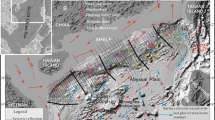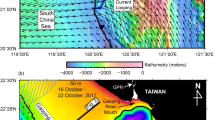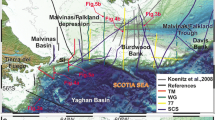Abstract
There are some active bottom currents on the northern continental slope of the South China Sea (SCS). Reflection seismic profiles show that the bottom current channels occur in the water depth range of 1000 to 2700 m, extending from the NE to the SW, leading to accumulation of discontinuous drifts with higher sedimentation rates on the eastern side of the channel. The stacking pattern of the layers suggests that these drifts propagated southwestward, following the direction of the bottom currents. One sedimentary drift to the southeast of the Dongsha Islands has the highest sedimentation rate of 97cm/ka in the last 12 ka. The sedimentary characteristics of the sediment layers indicate that these bottom currents are most likley caused by the water movement of a branch of the West Pacific Ocean Current, which enters the northern SCS via the Bashi Strait. Once formed, the bottom currents transport sediments along the northern slope of SCS southwestward and finally disappear into the central basin of the SCS. Due to the bottom current activity, the deep-sea sedimentary process in the northern SCS is complex.
Similar content being viewed by others
References
McCave I N, Tucholke B E. Deep-current controlled sedimentation in the Western North Atlantic. In: Vogt P R, Tucholke B E, eds. The Geology of North America M, the Western North Atlantic Region. Geol Soc Am, 1986. 451–467
Shanmugam G, Spalding T D, Rofheart D H. Processes sedimentology and reservoir quality of deep-marine bottom-current reworked sands (sandy contourites): an example from the Gulf of Mexico. Am Assoc Pet Geol Bull, 1993, 77(7): 1241–1259
Viana A R, Faugères J C, Kowsmann R O, et al. Hydrology, morphology and sedimentology of the Campos continental margin, offshore Brazil. In: Stow D A V, Faugères J C, eds. Contourites, Turbidites and Process Interaction. Sediment Geol, 1998. 115: 133–157
Stow D A V, Faugères J C, Viana A, et al. Fossil contourites: a critical review. Sediment Geol, 1998, 115: 3–31
Stow D A V, Mayall M. Deep-water sedimentary systems: new models for the 21st century. Mar Pet Geol, 2000, 17: 125–135
Lobo F J, Hernández F J, Somoza L, et al. Patterns of bottom current flow deduced from dune asymmetries over the Gulf of Cadiz shelf (southwest Spain). Mar Geol, 2000, 164: 91–117
Uenzelmann-Neben G. Seismic characteristics of sediment drifts: an example from the Agulhas Plateau, southwest Indian Ocean. Mar Geophys Res, 2001, 22: 323–343
Schut E W, Uenzelmann-Neben G, Gersonde R. Seismic evidence for bottom current activity at the Agulhas Ridge. Glob Planet Change, 2002, 34: 185–198
Sarnthein M, Pflaumann U, Wang P X, et al. eds. Preliminary report on Sonne-95 cruise “monitor monsoon” to the South China Sea. Reports, Geol-Palaont Inst Uni Kiel, 68. 1994, 1–205
Wang L, Sarenthein M, Erlenkeuser H, et al. East Asian monsoon climate during the late Pleistocene: high-resolution sediment records from the South China Sea. Mar Geol, 1999, 156: 254–284.
Wang P X, Prell W L, Blum P, et al. Proceedings of the Ocean Drilling Program, initial reports South China Sea, Volume 184, College Station TX, 2000, 18–20
Shao L, Li X H, Wei G J, et al. Provenance of a prominent sediment drift on the northern slope of the South China Sea. Sci China Ser D-Earth Sci, 2001, 44(10): 919–925
Wei G, Liu Y, Li X H, et al. Major and trace element variations of the sediments at ODP Site 1144, South China Sea, during the last 230 ka and their paleoclimate implications. Paleogeogr Paleoclimatol Paleoecol, 2004, 212: 331–342
Buehring C, Sarnthein M, Erlenkeuser Helmut. Toward a highresolution stable isotope startigraphy of the last 1.1 million years: Site 1144, South China Sea. In: Prell W L, Wang P, Blum P, et al. eds. Proc ODP, Sci Results, 184, 2004. 1–29
Wyrtki K. Scientific results of marine investigations of the South China Sea and the Gulf of Thailand 1959–1961, Univ of California at San Diego, Naga Rep, 1961, 2: 1–195
Li L, Wu R, Guo X. Seasonal circulation in the South China Sea—A TOPEX/POSEIDON satellite altimetry study. Acta Oceanol Sinica (in Chinese with English abstract), 2000, 22(6): 13–26
Zhang Y, Zhang Z, Wu H, et al. Numerical simulation of Kuroshio Circulation. Acta Oceanol Sinica (in Chinese with English abstract), 2003, 25(3): 120–128
Yang H, Liu Q. A summary on ocean circulation study of the South China Sea. Adv Earth Sci (in Chinese with English abstract), 1998, 13(4): 364–368
Chao S Y, Shaw P T, Wu S Y. Deep water ventilation in the South China Sea. Deep Sea Res, Part I, 1996, 43: 445–466
Sun X, Li X, Beug H J. Pollen distribution in hemipelagic surface sediments of the South China Sea and its relation to modern vegetation distribution. Mar Geol, 1999, 156: 211–226
Luedmanna T, Wong H K, Wang P X. Plio-Quaternary sedimentation processes and neotectonics of thenorthern continental margin of the South China Sea. Mar Geol, 2001, 172: 331–358
Luedmann T, Wong H K, Berglar K. Upward flow of North Pacific Deep Water in the northern South China Sea as deduced from the occurrence of drift sediments. Geophys Res Lett, 2005, 32: L05614
Huang C Y. Taiwan Island tectonics. Taibei: Geol Soc China (in Chinese), 2002. 1–207
Chen J, Zheng L, Chen R, et al. Fluxes and constituents of particulate matter in the South China Sea in comparison with sediment accumulation rates. Acta Sedimentol Sinica (in Chinese with English abstract), 1998, 16(3): 14–19
Faugeres J C, Mézerais M L, Stow D A V. Contourite drift types and their distribution in the North and South Atlantic Ocean basins. Sediment Geol 1993, 82: 189–203
McCave I N, Lonsdale R E, Hollister C D, et al. Sediment transport over the Hatton and Gardar contourite drifts. J Sediment Petrol, 1980, 50(4): 1049–1062
Rhein M, Stramma L, Send U. The deep western boundary current: water masses and transport. J Geophys Res, 1995, 100(C2): 2441–2458
Robinson S G, McCave I N. Orbital forcing of bottom current enhanced sedimentation on Feni Drift, NE Atlantic, during the mid-Pleistocene. Paleoceanogr, 1994, 9(6): 943–972
Author information
Authors and Affiliations
Corresponding author
Additional information
Supported by the National Natural Science Foundation of China (Grant Nos. 40276019 and 40238060) and the National Key Basic Research Special Foundation Project of China (Grant No. G2000078500)
Rights and permissions
About this article
Cite this article
Shao, L., Li, X., Geng, J. et al. Deep water bottom current deposition in the northern South China Sea. SCI CHINA SER D 50, 1060–1066 (2007). https://doi.org/10.1007/s11430-007-0015-y
Received:
Accepted:
Issue Date:
DOI: https://doi.org/10.1007/s11430-007-0015-y




